Finding the Suitable Software Development Partner for Innovative Solutions
Finding the Suitable Software Development Partner for Innovative Solutions
Blog Article
Dedicated Developers vs. In-House Teams: Which Is Right for You?
The decision in between utilizing dedicated developers and preserving an internal team is a considerable one that can influence the trajectory of your projects and general service strategy. Conversely, in-house groups contribute to a cohesive firm society and a nuanced understanding of long-term goals.
Understanding Dedicated Developers
The expanding demand for specialized abilities in the tech sector has brought about the introduction of committed programmers as a practical service for many organizations. These experts are usually contracted on a task basis, permitting companies to utilize certain experience without the long-lasting commitment related to full time hires. Dedicated designers are frequently embedded within a client's team, supplying adaptability and scalability to meet project needs.
This design allows organizations to access a global skill swimming pool, which is particularly helpful in a quickly progressing technological landscape. Dedicated designers can be sourced from various geographical places, ensuring that companies can locate the right capability at competitive prices. They usually bring a riches of experience and expertise, having actually serviced diverse tasks across different sectors.
Moreover, devoted programmers can concentrate solely on the tasks available, improving efficiency and performance. They are outfitted to integrate perfectly into existing operations, working together closely with in-house groups to achieve project purposes. This strategy not only lowers the problem of recruitment and training but likewise enables companies to stay nimble, adapting swiftly to transforming market needs and technological developments.
Benefits of In-House Teams

Additionally, in-house teams tend to have a much deeper understanding of the firm's mission, values, and goals. This placement can enhance staff member engagement and motivation, as group participants really feel a lot more connected to their job and the organization's success. Furthermore, having a specialized internal team enables much better positioning of goals and techniques, as these participants are constantly concentrated on the business's priorities.
Internal teams additionally promote quicker decision-making procedures, as they can react much more swiftly to adjustments and obstacles. The established connections and familiarity with business protocols permit structured operations and lowered miscommunication. Ultimately, the combination of a natural society, alignment with business goals, and reliable interaction makes internal groups a useful asset for several organizations, especially those seeking to grow long-lasting development and innovation.
Price Factors To Consider
When evaluating cost considerations, both committed programmers and internal teams existing distinct economic effects for companies. Engaging devoted developers typically involves a pay-per-project or per hour rate version, which can be affordable for organizations with varying job needs. This strategy enables versatility in scaling resources up or down, guaranteeing that firms just spend for the solutions they require.
In contrast, internal teams involve dealt with prices, consisting of incomes, advantages, and overhead costs such as workplace and equipment. While this design offers better control and prompt accessibility of resources, it may lead to higher long-lasting expenditures, specifically if the workload does not warrant a permanent team.
Additionally, business must consider the go to this web-site concealed expenses related to recruitment and training of internal staff members, which can even more strain budget plans. Sometimes, the moment and sources invested in managing an in-house group can detract from the company's core company objectives.

Job Management and Flexibility
Job administration and adaptability are vital factors that affect the option in between committed programmers and in-house teams. Committed programmers normally use a high degree of adaptability, permitting companies to scale sources up or down based upon project demands. This dexterity can be specifically useful for services experiencing fluctuating work or those seeking to introduce rapidly. Devoted groups usually have actually established processes for managing projects properly, leveraging details techniques like Agile or Scrum, build an ecommerce website from scratch which help with iterative progress and adaptability.

Ultimately, the option between in-house groups and modular web design dedicated designers depends upon the wanted level of versatility and the particular project monitoring requirements. Firms need to assess their operational characteristics, job complexity, and resource accessibility to establish which option straightens finest with their tactical goals.
Making the Right Option
Selecting the best development method-- internal teams or specialized programmers-- calls for a mindful assessment of different variables that align with a company's calculated goals. software development staff augmentation. Consider the nature of the task. If it demands specialized skills or a fast scale-up, dedicated developers might be preferable. Conversely, internal teams can give better connection and assimilation with existing workers.
Following, evaluate your budget plan. Committed designers typically present a cost-effective option for short-term tasks, while internal groups might incur greater long-lasting expenditures because of incomes, benefits, and expenses costs. Evaluate the degree of control and cooperation preferred; internal teams normally cultivate stronger interaction and alignment with business culture.
If instant results are needed, dedicated developers can be onboarded quickly, whereas developing an in-house team takes time for employment and training. If constant growth is vital, spending in an in-house team might produce better returns over time.
Conclusion
In conclusion, the decision in between internal groups and committed designers hinges on project needs and business objectives. On the other hand, in-house teams grow a cohesive society and deeper alignment with long-lasting objectives.
The choice between using dedicated programmers and maintaining an internal team is a significant one that can affect the trajectory of your jobs and overall service technique.Task management and versatility are critical factors that affect the selection in between internal teams and devoted developers. nearshore software development.In contrast, in-house teams might succeed in keeping a constant job administration structure due to their experience with the company's society and lasting objectives. Committed designers often offer a cost-efficient option for temporary jobs, while in-house groups might incur greater long-term expenses due to salaries, advantages, and overhead expenses.In conclusion, the decision between dedicated designers and internal teams pivots on job requirements and organizational objectives
Report this page